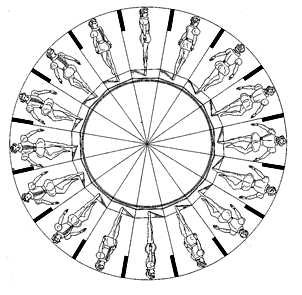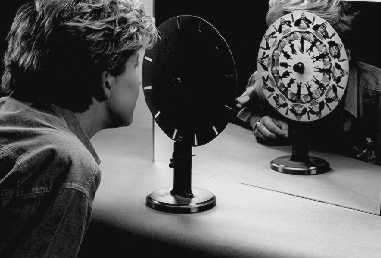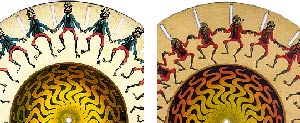1 |
On 10 December 1830, Michael Faraday(1791-1867) gives a lecture at the Royal Institution. The publication appears in February 1831: "On a peculiar Class of Optical Illusions". Continuing on what Peter Mark Roget (1779 - 1869) had published in the Philosophical Transactions, he describes two parallel discs, revolving on the same axis, in opposite directions, each having 16 cogs. When viewed in a mirror a stationary image is seen. He does not refer to Plateau's work, done before 1831 and which had been published in the Correspondance mathémathique et physique. Later Faraday writes that the honour is due to Plateau. |
 |
Draft for a phenakistiscope disc representing a pirouetting
dancer J. Plateau, Corresp. Math. Phys. 1832 VII p.291 In "Sur un nouveau genre d'illusions d'optique", Plateau describes the construction and the action of a disc with 16 slits and 16 intermediate sectors. When 16 identical drawings are put in the sectors, one sees a stationary image, when looking through the slits at the revolving disc in a mirror. This is in fact the experiment of Faraday. The brilliant contribution of Plateau comes when in stead of putting 16 identical images in the sectors he draws 16 images, which change little by little. Because of the visual persistence the images seen in swift succession will fade into each other and a suggestion of movement is created. It is for this reason that Joseph Plateau is cited as the precursor of the movie, more accurately he is the precursor of the animation film.
|

Photo MD,
Museum for the History of Sciences, Ghent
|
|
|
Joseph Plateau and the artist-painter J.B. Madou Melanie Christine Lannuyer (1808-1896), stepsister of Quetelet marries the painter Jean Baptiste Madou (1796-1877) in 1833. In this way Plateau gets into contact with Madou, a relationship that is not just superficial, since a real collaboration between the scientist and the artist develops. Two discs (a phenakistiscope-anorthoscope combination) for which the painter J.B. Madou drew the first image are extant. One depicts a monk, the other the head of a devil. Plateau then painstakingly derives the other images: "L'un
de nos grands artistes, M. Madou, a bien voulu dessiner, à
ma prière, le modèle de la tête au moment où
elle souffle avec le plus de force. J'ai transporté ensuite
ce dessin dans l'un des compartiments du disque, en augmentant les
dimensions angulaires de toutes les parties dans le rapport de 4
à 5, puis je l'ai modifié convenablement dans les
autres compartiments, et j'ai apporté les plus grands soins
à l'exécution de ces figures.", writes Plateau.
|
|
Disc with flower and bee. |
It is remarkable that in the original paper the discs and the experiment itself are described, but they receive no name. It is only in a later paper in 1831 "Des illusions optiques sur lesquelles se fonde le petit appareil appelé récemment Phénakisticope" that a name is introduced. It is not clear who introduced the name "phénakisticope". The title of the paper suggests that it was not Joseph Plateau himself. Ackerman in London sells the discs in 1833 under the name "Fantascope", Alphonse Giroux in Paris introduces them first as "phénakisticope", later as "phénakistiscope". Plateau himself also uses the term "phénakisticope". To day the spelling "phenakistiscope" is preferred.
 |
Detail of the original hand-coloured disc compared
to a printed version. The figure which is completely red is a hand-coloured draft for a disc. The red-and-blue figure is the printed version by Ackermann (London). Only the first discs printed by Ackermann bear the mention "by prof. Plateau". Collection J.Plateau, Ghent |